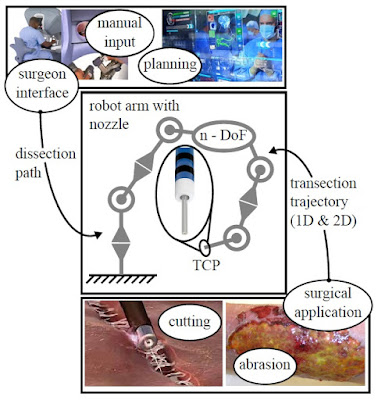Waterjet robotic surgery
At DLR, a cool new surgical technology is being explored:
"In waterjet surgery a thin and high pressure waterjet is used to
prepare soft tissue. This method was first presented in the British
Journal of Surgery by Papachristou and Bartes as "Resection of the liver
with a waterjet" in 1982.
There, the selective aspect which is the main advantage of the
waterjet method is introduced. Soft tissue as e.g. parenchyma is washed
away whereas structures with a higher mechanical resistance against the
waterjet impact like nerves and vessels remain intact. This leads to
less interoperative loss of blood and less parenchymal trauma. These
effects have also been acknowledged by various other publications.
Another advantage of the method is that the cell structures at the
borders of the cut stay intact since there is no thermal damage.
In open surgery preparing soft tissue by waterjet is a repetitive
process as only few cell layers are washed away when moving the waterjet
over the tissue. This results in the requirement that the waterjet has
to be moved continually during the preparation process. The movement is
quite easy to perform in open surgery but is very difficult in minimally
invasive interventions due to the kinematic restriction given by the
trocar.
By use of robotics these restrictions can be overcome and the
waterjet method can be used in the same manner as in open surgery.
Therefore the waterjet is no longer limited to a few minimally invasive
cases but can be used in several minimally invasive interventions."
Source: IEEE TBME, DLR Robotics and Mechatronics Center



Comments